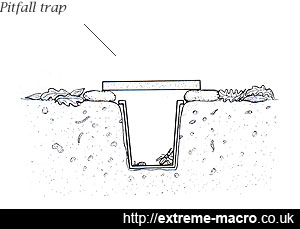Catch Beetles Using A Pitfall Trap
by Johan J Ingles-Le Nobel
Last updated August 31, 2017
Pitfall traps are extremely cheap to make and can be added to any garden. You are likely to trap beetles and other insects, as well as spiders and slugs. Apidae, Araneae, Carabidae, Diptera, Formicidae, Isopoda, Vespinae are all common catches in pitfall traps.
Making A Pitfall Trap

A pitfall trap - insects fall in and they can't get back out. One of the easiest ways to catch beetles, but you must ensure that you check them daily.
Making a basic pitfall trap to catch beetles for your macro shots really is one of the easiest insect traps you'll ever make in your life. All you need is a plastic cup that's thin enough to use a needle to make holes in the bottom, a cover against rain and a few small stones.
Make some small holes in the bottom so that if it rains, the water doesn't drown your catches, dig a small hole, cover and you're set.
Pitfall Trap Bait
I have always found that pitfall traps seem to work better if you bait them with something to catch an insect's attention. Rotting fish seem to catch the most beetles for me, especially burying beetles. But WOW rotting fish really honks, so mine are set in a forest a few hundred yards up the road. Alternatively, try an old sock suspended above the trap filled with dung - this seems to have achieved success in Africa on dung beetle expeditions.
Pitfall Trap Use
It is your responsibility to check these daily, especially if it's been raining and larger amphibians like toads are out. Animals that get stuck in there can die. Not only that, but a large ground beetle having fallen into a dry trap will proceed to eat anything else that happens along. Pitfall traps may have "exclusion barriers" such as a selective grid or "roof" to exclude unwanted fauna (predators, non-target species) and rain.
Leaf litter added to the trap from the site provides shelter and moisture which prolongs survival of trapped animals. A saturated sponge provides high moisture levels for trapped amphibians. Remove the pitfall trap if you're no longer using it.
Cheap, plastic drinks cups with a rim diameter of 7cm (internal volume 200-250ml) are great. But, carefully does it - it is no good at all if there is even the slightest lip showing above ground as insects will simply walk around the circumference. Even bits of debris and foliage that lie across the top of the trap will act like little walkways.
Use A Double Hull!
The use of double cups is recommended. The whole point of having two cups is that you can take the inner one out and empty excess soil, preferably off-site. The inner cup is now replaced with a clean one. The outer cup protects the inner one and allows subsequent rapid emptying of the inner cup.
Pitfall Trap Colour
White or yellow pitfall traps catch more Apidae, Araneae, Carabidae, Diptera and Formicidae than other colours (tested against green and brown).
Pitfall Trap Material
In a 1975 study, it was found that glass traps are more efficient for their size than metal or plastic. That said, the problem with glass containers is that they collect rainwater and your catch may drown.
Metal Strips
You can improve the efficiency of your pitfall trap by using 10cm wide strips of metal or plastic, and stick them in the ground leaving 5cm exposed, radiating them outwards from your trap so that anything walking into them gets guided towards the trap. It's a bit ugly but it makes the catchment area a bit bigger.
Killing Agents
Some people miss out the small holes and pour in something into the bottom to act as a killing agent. This works too, although the chance of catching toads or frogs makes me personally dislike using this method.
Pitfall Trapping Downloads
Related Articles





